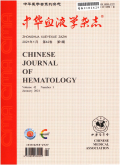预处理前多参数流式细胞术监测的微小残留病对急性髓系白血病异基因造血干细胞移植预后的影响
Effect of minimal residual disease monitoring by multiparameter flow cytometry pre-conditioning on prognosis of acute myeloid leukemia after allogeneic hematopoietic stem cell transplantation
摘要目的 分析预处理前多参数流式细胞术(MFC)监测的骨髓微小残留病(MRD)对急性髓系白血病(AML)异基因造血干细胞移植(allo-HSCT)预后的影响,探讨MFC监测MRD在AMLallo-HSCT预后评估中的价值.方法 回顾性分析2012年4月至2015年3月行allo-HSCT的186例AML患者,预处理前骨髓细胞形态学均达第1次完全缓解(CR1).采用8色MFC对预处理前骨髓进行MRD检测,任何水平异常均定义为MRD阳性.结果 ① 186例AML患者中151例MRD阴性;35例MRD阳性,其中25例MRD< 1%,10例MRD为1%~3%.②2年总体无病生存(DFS)率为80.0%(95%CI 68.5%~92.3%).与MRD阴性组比较,MRD阳性组DFS率低[62.9% (95% CI 50.6%~75.2%)对88.9% (95%CI 76.6%~100.0%),P<0.001]、复发率高[11.4%(95% CI 4.1%~29.0%)对3.3% (95%CI0.6%~20.9%),P=0.003]、非复发死亡率(NRM)高[25.7%(95%CI 8.1%~43.3%)对7.9%(95%CI l.3%~26.5%),P=0.001].继发性AML组DFS率低(P=0.004),NRM高(P=0.003).③多因素分析结果显示预处理前MFC检测的MRD阳性是DFS[HR=4.565(95% CI 2.918~9.482),P<0.001]、复发[HR=5.854(95% CI l.538~22.288),P=0.010]及非复发死亡[HR=3.379(95%CI l.361~8.391),P=0.009]的独立危险因素.结论 预处理前MFC监测的MRD阳性是影响allo-HSCT治疗CR1-AML独立危险因素,MFC监测MRD可用于AML allo-HSCT的预后评估.
更多相关知识
abstractsObjective To investigate the effect of minimal residual disease (MRD) monitoring by multiparameter flow cytometry (MFC) pre-conditioning on prognosis of acute myeloid leukemia in first complete remission (CR1-AML) after allogeneic hematopoietic stem cell transplantation (allo-HSCT),and to explore the value of MRD monitoring by MFC in the prognosis evaluation on allo-HSCT in CR1-AML.Methods Between April 2012 and March 2015,consecutive 186 patients with CR1-AML who underwent allo-HSCT were analyzed retrospectively.MRD in BM before conditioning was detected by eight-color MFC.Any level of residual disease was considered to be MRD positive.Results ①Of 186 patients,MRD was negative in 151 patients,positive in 35 patients (< 1% in 25 patients and 1% to 3% in 10 patients).② With the median follow up of 18 (5-41) months,two-year DFS was 80.0% (95%CI 68.5%-92.3%).Univariate analysis showed that MRD positive patients had lower DFS [62.9% (95%CI 50.6%-75.2%) vs 88.9% (95% CI 76.6%-100.0%),P < 0.001],higher relapse [11.4% (95% CI 4.1%-29.0%) vs 3.3% (95% CI 0.6%-20.9%),P=0.003] and higher NRM [25.7% (95% CI 8.1%-43.3%) vs 7.9% (95% CI 1.3%-26.5%),P=0.001] after HSCT compared with that of MRD negative patients.Secondary AML showed lower DFS than primary AML [60.0% (95%CI 42.4%-76.6%) vs 86.0% (95%CI 68.4%-100.0%),P=0.004].(③)Multivariate analysis indicated that MRD positive pre-HSCT was the independent risk factor on DFS [HR=4.565 (95%CI 2.918-9.482),P < 0.001],relapse [HR=5.854(95%CI 1.538-22.288),P=0.010[and NRM [HR=3.379(95%CI 1.361-8.391),P=0.009] after allo-HSCT in CR1-AML.Conclusion MRD positive pre-conditioning was the only negative impact factor for patients with CR1-AML after allo-HSCT.MRD by MFC can be used to assess the prognosis of CR1-AML after allo-HSCT.
More相关知识
- 浏览406
- 被引18
- 下载210


相似文献
- 中文期刊
- 外文期刊
- 学位论文
- 会议论文



 换一批
换一批 换一批
换一批



